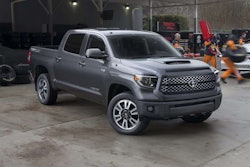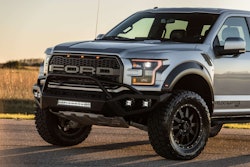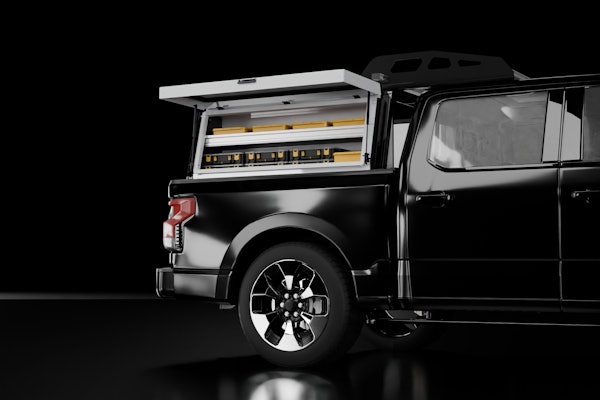 Chevy’s 2017 Silverado 2500 4×4.
Chevy’s 2017 Silverado 2500 4×4.Photos: Tom Quimby
One thing comes to mind following my week-long test-drive in a 2017 Chevy Silverado 2500 High Country 4×4: power and plenty of it.
The butte red metallic double-cab came equipped with Chevy’s redesigned 6.6-liter Duramax turbo diesel, which continually impressed in competitive city traffic and on the highway, including cut-throat Interstate 10 where towing was nearly effortless.
The new Duramax delivers 445 horsepower and 19 percent more torque at 910 foot pounds. I first noticed just how much punch this beast packs when turning onto U.S. 98 in Panama City.
As you can imagine, getting onto one of the busiest roads in our beach-bound area during spring break can be a bit of a challenge. But the task came easily with Silverado’s quick, quiet diesel. A responsive throttle didn’t need much convincing to quickly get this 10,000 lb. GVWR truck up to the 45-mph speed limit.
The truck’s quickness also came in handy on busy Tallahassee roads where lane changing is a constant and if not exercised in a timely manner can mean missing a turn. That never happened in the Silverado. I confidently kept up and negotiated traffic and felt empowered on roads that often prove frustrating with a frenetic pace.
An Allison 1000 six-speed transmission works well under pressure and quickly transfers power to 20-inch chromed aluminum wheels. However, in-city driving below 50 mph may take some getting used to, depending on your personal preference and pocketbook.
Case in point: I kept hearing the engine run fast and strong on 35 and 45 mph roads. The tachometer was registering roughly 1,800 rpm before the transmission shifted at 48 mph and dropped the tach back to around 1,200 rpm.
Fuel consumption while driving in the city averaged around 12 mpg, according to the truck’s calculation, which was based on the last 25 miles of driving. In case you’re wondering, Chevy allows the mpg average to be figured at different mileage intervals depending on your selection.
A 230-mile round trip from Panama City to Tallahassee left me with an average of 18.5 mpg according to the truck’s trip odometer (I reset it before heading out). Some of that trip consisted of city driving, but the majority was carried out on the highway. The truck’s handling and suspension quickly imparts a sense of confidence. I found that out fast while driving on the winding, bumpy roads in my neighborhood.
Four-wheel-drive spares me from embarrassment
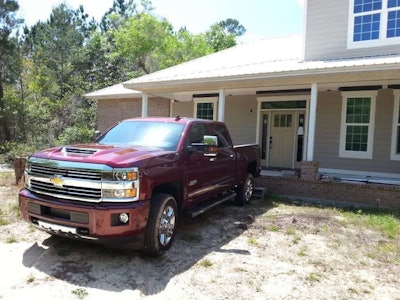
A wise man once said, “Never put your truck into four-wheel-drive until you need it.” Sound advice. The idea is that if you get stuck while in two-wheel drive, you at least still have the option of switching to four-wheel-drive to get out. But if you start in 4×4 and get stuck without a winch or a buddy nearby to pull you out, then you’re obviously out of luck and will have to make that embarrassing phone call.
The truck I was given had no winch and no one was around to pull me out. But I did have a four-wheel drive switch. Though it’s not required, out of habit I put the truck in neutral first before making the switch to four-wheel-drive high.
After turning the switch, the instrument panel’s display lit up and within a few short seconds a message confirmed that I was now in four-wheel-drive. I tried the accelerator again and this time I was moving. No phone call required. Nice.
I drove further down a dirt road to get a better feel for the truck in four-wheel-drive. It handled nicely, even while turning.
Adventures in towing on I-10
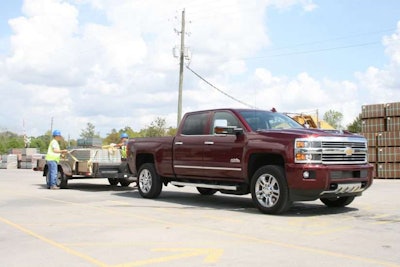
It just so happened that my Dad needed two pallets worth of pavers about 60 miles away at Block USA in Defuniak Springs. We took Dad’s friend along for the ride. Both of them are seasoned—and I use that word respectfully—pickup drivers who have towed boats, cars and God knows what else through the years.
The adventure started by placing a GM-supplied 2-inch receiver inside the Silverado’s 2 ½-inch receiver in the rear. Though Dad was a little concerned that the hitch pin would not be long enough to make it through both receivers, it worked out just fine.
Next up came the task of backing up the truck to the 16-foot, dual-axle flatbed. While overall I like the Silverado’s back-up camera, it was difficult finding the trailer’s black tongue on the info screen. Though the sun was shining brightly around 9 a.m. that morning, we were parked on top of dark leaves in the shade of some large oaks, and the truck’s monitor just had a hard time offering up a sharp image of the tongue. Still, on a second attempt, I was able to get the trailer ball right under the tongue.
After hooking up the seven-pin trailer connector, a message popped up on the instrument panel display stating that the trailer had been successfully connected. That was nice. However, it would have been nicer if a follow-up message gave instructions on setting the gain for the trailer’s electronic brakes. There was nothing in the manual.
It would have been nice seeing an image of where to make the adjustment – maybe next year. After some hunting around, I found the plus and minus buttons on the far left side of the dash under the small icon of a trailer. Electronic brake gain can be set from 0 to 10. I set it at 6. I also engaged the tow haul mode which takes some of the strain off the transmission by changing shift points.
After making a light check on the trailer, we were off and running to Defuniak. The first thing I noticed while towing was that I really couldn’t notice the trailer. Because the trailer tires had been inflated to 65 psi, we anticipated a bumpy ride on the way over, but that wasn’t the case. We were all impressed by the smooth ride.
Getting onto I-10 from State 77 was easy with that truck’s powerful 6.6-liter Duramax turbo diesel. Of course, the real test would be merging onto the highway during our return trip with all those pavers.
After loading up at Block USA with roughly 6,000 lbs. of pavers (maximum towing is 18,100 lbs.) we decided to test the brakes again before getting back onto the main road. I got the Silverado up to about 30 mph and hit the brakes hard. Both truck and trailer came to a quick stop. We all felt more confident about that long ride home.
While it now felt like I was towing something, I never lost confidence in the truck’s ability to get up and go. Frankly, it’s got plenty of power to spare. Getting onto I-10 was easy. It got up to speed in no time. Despite some minor grades along the way, cruise control kept working flawlessly and made the climb without skipping a beat.
The exhaust brake on the Silverado brought on even more confidence. I actually looked forward to braking. It works that well. When mashing the brake, I always knew there was going to be plenty of room between us and the vehicle ahead. Like I said, it brings on a lot more confidence when towing.
Because the info screen on the instrument panel allows you to monitor transmission temperature, I couldn’t help but keep an eye on how hot that six-speed Allison would run in and out of tow haul mode. Keep in mind that it’s difficult to accurately test the transmission unless the conditions are the same for each run. Still, I had to conduct an impromptu test. All apologies to GM’s very capable engineers.
Without tow haul mode, the transmission got as hot as 183 degrees. With tow haul mode engaged it got down to as low as 165.
Bottom line, towing in the Silverado 2500 was impressive. Chevy has really done their homework in making the job as smooth and safe as possible. Features like Stabilitrack stability control with trailer sway control lend even more confidence.
Safety features
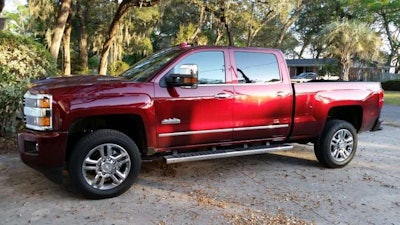
As I edged closer to the tree, more yellow lights illuminated on the display. This got me curious, so of course I had to find out just how close I could get to the tree before setting off that final row of lights. Once I got about a foot away from the tree, a band of red lights came on and the seat vibrated five times. Next to a hand dropping down from the visor and slapping you across the face, a vibrating seat is a good attention-getter.
Parking assist can be turned on or off at the touch of button. I kept it on during the entire week that I had the truck because it had quickly proved its worth. Front and rear parking assist along with the rear vision camera work at speeds of less than 5 mph. The sensors will detect objects up to eight feet behind and four feet in front. An object has to be at least 10 inches off the ground to be detected. Humid weather can shorten detection distances.
Another safety feature that surprised me with its effective response time was forward collision alert or FCA. While two lane country roads can be scenic, they can also be dangerous. I was traveling on one such road in northwest Florida when the car in front of me slowed down quickly to make a left-hand turn. My seat vibrated and a rectangular red light about three inches long and a ¼-inch wide was projected on the lower, left side of the windshield. It was hard to miss and really reinforced the notion of safety in this truck.
For you tailgaters that can’t seem to get anywhere fast, an amber light will flash in place of the red one if you get too close to the vehicle ahead.
FCA works at speeds above 25mph and will detect objects within 197 feet. The owner’s manual states: “It does not warn of pedestrians, animals, signs, guardrails, bridges, construction barrels or other objects.”
Rear seat detection was another plus. After shutting down the truck, the message would pop up on the screen reminding me that there was either people or cargo riding along in the back of the cab.
Bottom line, I can’t imagine ever running low on power, comfort and safety in the 2017 Chevy Silverado 2500 High Country with the new 6.6-liter Duramax turbo diesel. This truck definitely has capability where it counts.
EDITOR’S NOTE: This Test Drive has been condensed from its original two-part story. Click here to read Part 1 and Part 2 in full.


